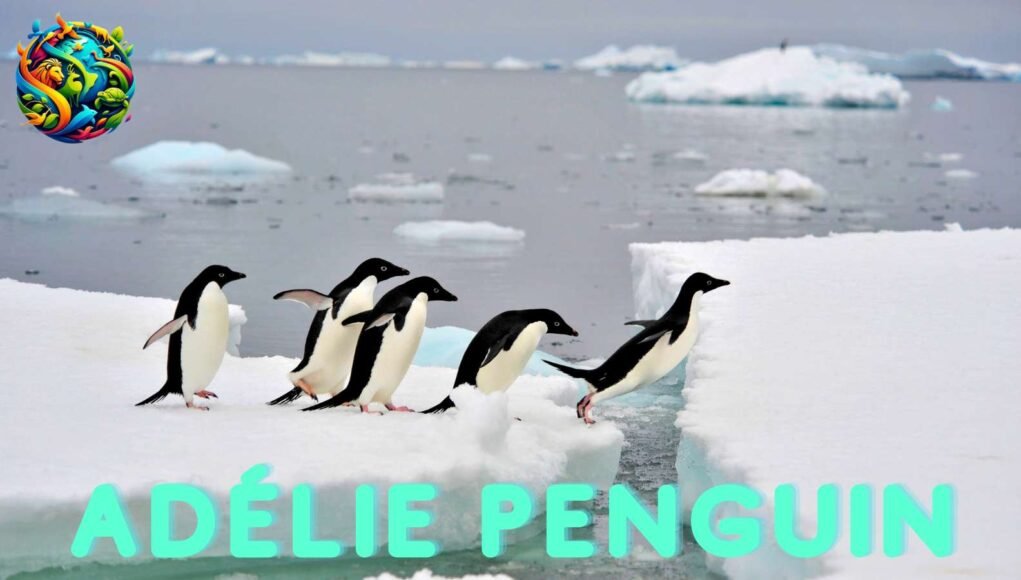Adélie Penguin: The Fearless Explorer of Antarctica
Introduction:
The Adélie Penguin (Pygoscelis adeliae) is one of the most iconic and well-studied penguin species, native to the harsh yet stunning landscapes of Antarctica. Named after Adèle Dumont d’Urville, the wife of the French explorer Jules Dumont d’Urville, these penguins are known for their bold personalities, remarkable swimming abilities, and vital role in the Antarctic ecosystem.
Despite the freezing temperatures and fierce winds of their homeland, these birds thrive in one of the most extreme environments on Earth, demonstrating remarkable resilience.
Amazing Facts:
- Extreme Swimmers: They can dive 575 feet (175 meters) and hold their breath for up to 6 minutes.
- Fast runners: Unlike some penguins, they are excellent runners on land, often sprinting over ice.
- Sunbathing in the Cold: They expose their dark backs to the sun to absorb heat and regulate body temperature.
- Aggressive Defenders: Despite their small size, they fiercely defend their nests from predators and rivals.
- Massive Colonies: They form colonies of over 500,000 individuals, creating some of the largest bird gatherings on Earth.
- Stone Hoarders: Males collect and gift small stones to females as part of their courtship ritual.
Habitat and Food:
Habitat
Adélie Penguins are exclusively found in Antarctica and surrounding islands. They prefer:
- Rocky coastal areas: ideal for nesting and avoiding ice cover.
- Ice-free zones: essential for breeding colonies.
- Ocean waters near pack ice: Their primary hunting ground.
Diet
These penguins are carnivores, mainly feeding on:
- Krill: their primary food source.
- Fish: such as Antarctic silverfish.
- Squid and small cephalopods: Occasionally consumed.
They dive deep to catch prey, using their streamlined bodies and powerful flippers for efficient underwater movement.
Appearance:
- Size: 18–28 inches (46–71 cm) tall.
- Weight: 7.9–13.2 lbs (3.6–6 kg).
- Colour: classic black-and-white tuxedo look.
- Distinctive Features: A white ring around the eyes and a short, strong beak.
- Flippers: adapted for high-speed swimming, enabling them to reach up to 5 mph (8 km/h) in water.
These penguins look adorably clumsy on land but are incredibly agile in water, making them one of the best swimmers in the penguin family.
Types/Subspecies of Adélie Penguin:
The Adélie Penguin is a monotypic species, meaning it has no subspecies. However, populations in different regions vary slightly in size due to environmental adaptations.
Predators and Threats:
Predators
Adélie Penguins face threats from both land and sea:
- Leopard seals: their most dangerous predator, ambushing them in the water.
- Orcas (Killer whales): Occasionally prey on them.
- Skuas and Giant Petrels: Attack penguin eggs and chicks.
Threats
- Climate Change: Melting sea ice disrupts their breeding and feeding grounds.
- Overfishing: Depletes krill populations, their main food source.
- Human Activity: Pollution, oil spills, and research station disturbances pose risks.
Despite these threats, their population remains stable, with an estimated 10 million individuals.
Mating and Reproduction:
- Breeding Season: October to February.
- Nesting: They build nests out of pebbles, which are often stolen by rival males.
- Eggs: Females lay two eggs, incubated by both parents.
- Hatching: After 35 days, chicks emerge and stay under parental care.
- Fledging: At 7–9 weeks, young penguins become independent.
Males return to the same nest site each year, often reuniting with their mate from the previous season.
How Adélie Penguins Communicate:
Adélie Penguins use a combination of vocalisations, body movements, and displays to communicate:
- Trumpeting calls: used for mate recognition and territory defence.
- Beak pecking and flipper slaps: assert dominance or scare off rivals.
- Head bows and wing flaps: behaviours between mates.
They are highly social birds, often seen interacting in large groups and engaging in synchronised activities.
Adélie Penguins in Movies and Media:
Adélie Penguins have been featured in:
- “March of the Penguins” (2005): A famous documentary highlighting penguin life in Antarctica.
- “Happy Feet” (2006): Adélie Penguins appear as energetic, fun-loving characters.
- BBC Nature Documentaries: Showcasing their unique behaviour and environment.
Their charismatic nature and playful behaviour make them audience favourites in wildlife films.
Pronunciation of “Adélie Penguin” in Different Languages:
- English: Ah-deh-lee Pen-gwin
- French: Manchot Adélie
- Spanish: Pingüino Adelia
- German: Adéliepinguin
- Mandarin Chinese: 阿德利企鹅 (Ā dé lì qǐ é)
- Russian: Пингвин Адели (Pingvin Adeli)
FAQs:
Q: Why are Adélie Penguins famous?
A: They are one of the most studied Antarctic penguins, known for their bold personalities and resilience in extreme cold.
Q: Where do Adélie Penguins live?
A: They are native to Antarctica, preferring rocky coastal areas and pack ice.
Q: What do Adélie Penguins eat?
A: Their diet consists mostly of krill, fish, and squid, which they catch while diving.
Q: How long do Adélie Penguins live?
A: They typically live 10–20 years, depending on environmental conditions and predation risks.
Q: Are Adélie Penguins endangered?
A: No, but climate change and food shortages pose future risks to their population.
Q: How do Adélie Penguins stay warm?
A: They have thick feathers, a layer of fat, and huddle together for warmth.
Q: Can Adélie Penguins fly?
A: No, but they are excellent swimmers, reaching speeds of 5 mph (8 km/h) underwater.
Learn more about Adélie Penguin




